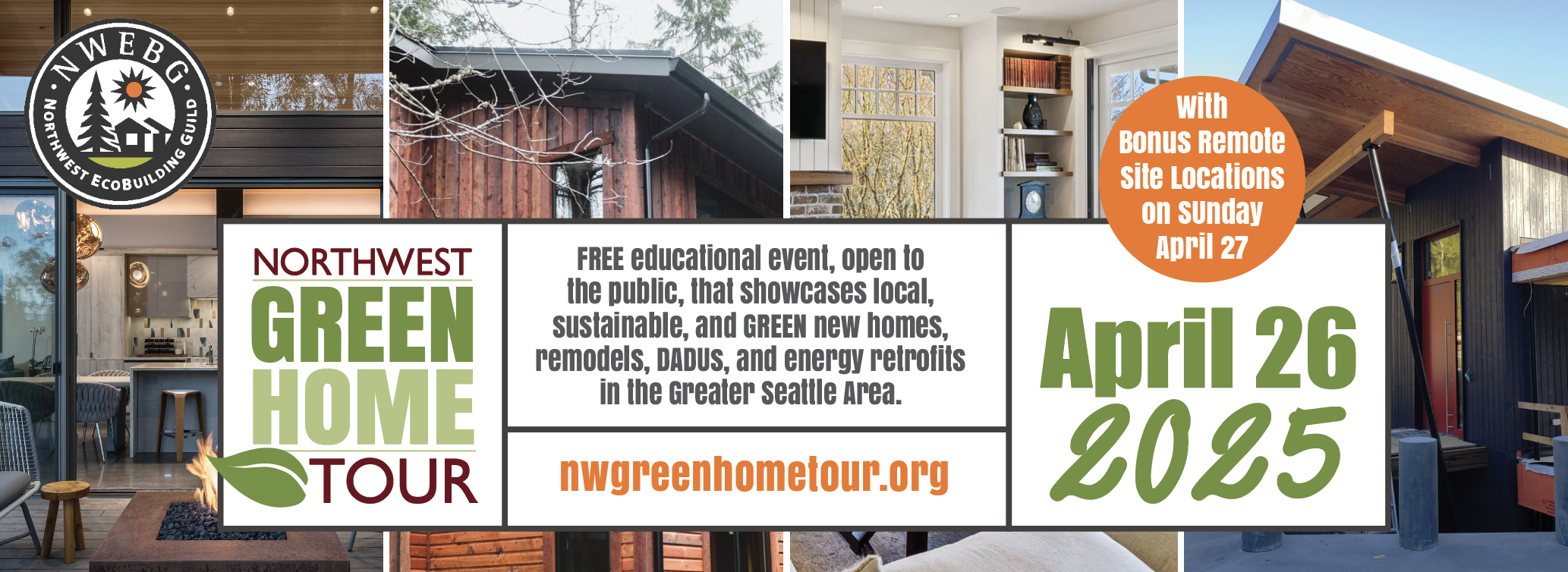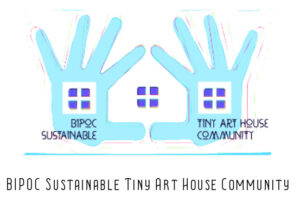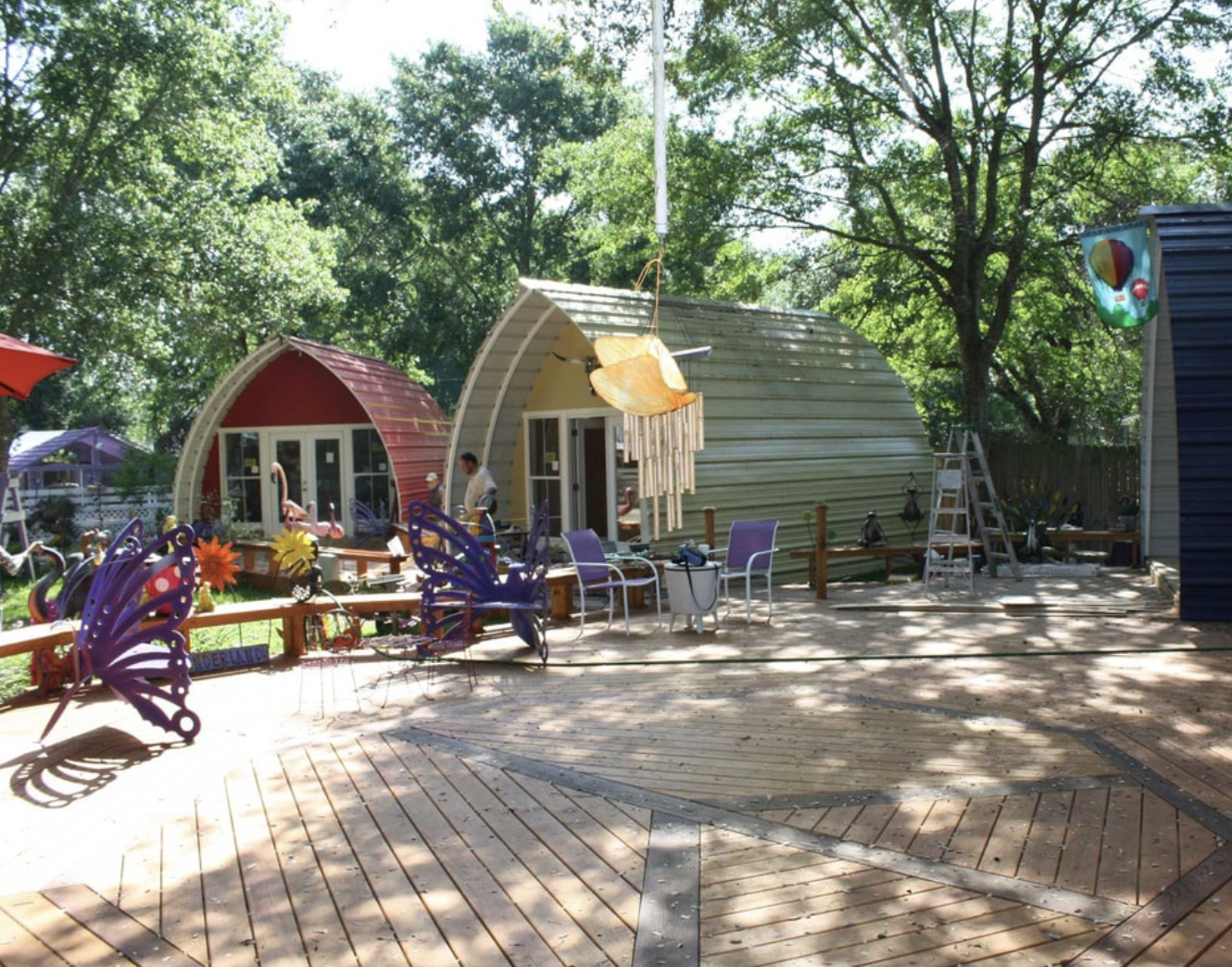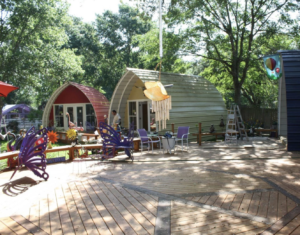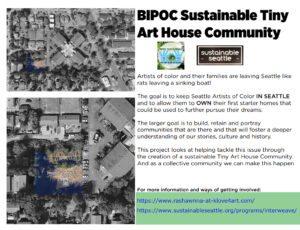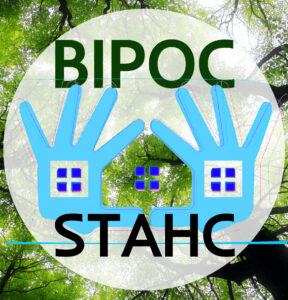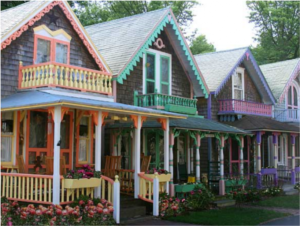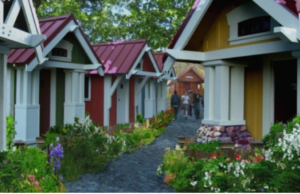Site Description
FEATURES: Built Green, Equity Endeavor
We are an urban community/neighborhood led project affiliated with National Tiny House Association, Regional memberships, with City and County Support through City of Seattle’s Equitable Development Initiative (EDI) and Foundations; the Seattle Foundation, Seattle Justices Funds SEED program funding.
Our organization believes in deep systemic transformation in hiring procedures; we hire based on a combination of skill sets, passion for project, BIPOC affiliation/identification, and ability to be trained intensively. We do not expect consultants to have a background in consulting, as we are more concerned with hiring folks of color from our own communities who desire to grow through professional development opportunities and with on the job training models…our investments in our consultants is an investment in our community. This allows folks to grow personally and professionally through their involvement with the project.
The prerequisites for hiring are:
- Passion for the Tiny Homes and/or purchasing their own tiny home
- Person of Color
- Must be an artist that has been impacted by displacement/ gentrification/ systemic & institutional racism, unsustainable living conditions
This hiring model allows BIPOC STAHC to work and train our consultants in building/creating, not only our program, but their own consulting business. This means that BIPOC STAHC must/does offer more in-depth professional training at the front end of the hiring process (about a year of shadowing through on the job training, and for our newly created artist residency program – its a 3 month intensive.)
This is a non-traditional way of hiring, designed to empower BIPOC artists at a livable wage, not as an employee (which keeps folks trapped in a colonialist model of wealth depletion.) It also allows us to hire those most impacted by the prison industrial complex, houseless individuals, those without a college degree and single parents. We do not dictate staff mandatory work hours (meaning; relying on traditional 9-5pm work hours) instead, consultants are required to complete and sign a contract that states they will complete 10-20 hours of work per week within their own time schedule/frame and produce agreed upon deliverables (our model is a merit/deliverable/outcomes based approach, not a traditional hourly time constrained model.)
We believe that everyone is of value, that everyone has:
- potential to learn,
- can excel if provided access, opportunities and exposure to comprehensive training, professional development, networking and
- the ability to collectively lead as colleagues not thru hierarchical management structures.
Because of the work model we embrace, this is a naturally healing project for women in leadership. We also seek to support our consultants towards their own career and home ownership goals through mentorship, as well as training and skill development where available.
Recent successes/wins:
We launched our fundraising platform Nov 2020 with the goal of raising $50k in 2021…to our surprise we have raised; $1,2000 online, $14,000 private donor, and $120k through foundations, grants and city support —– this was all in a span of 4 months! We have had to reevaluate our funding goals and reset our goal to $300k for 2021.
Our next goal of pilot model site launch:
- Build tiny houses
- Community engagement
- Site Art activation
- Home Ownership Artist Residency
Another amazing accomplishment was having our community development tiny art house model accepted by the Bellevue Art Museums BAM Architecture Exhibition in November 2021-April 2022 (this will allow us to publicly launch our large community engagement strategy to garner additional support and educate communities on the importance of wealth creation through home ownership. https://www.bellevuearts.org/
Our organization works at the intersection of equitable community development, sustainable green climate building solutions (including perma culture and solar panels), and racial equity/justice.
Challenges, issues, solutions, and bold visions we are prioritizing in our work (ex: health, energy, economic, litigation, renewal, democracy, land, air, water, labor, art, culture, other, all):
Our organization is reshaping the way government, foundations and communities view a healthy living environment by providing an economic framework that allows the most vulnerable to build a sustainable business and home. This includes having our houses be grid-tied (to be able to sell energy back to city), developing water catchment systems and grey water solutions to preserving water resources, democracy; where artists and community members collectively create a new way of coexisting, using art to build, educate and provide opportunities for business ownership, community engagement (around topics of interest) and labor (providing inclusive hiring practices.)
STAHC envisions establishing a new precedent for a viable, creative, build-to-own, environmentally sustainable, healthy, equity-building, low income BIPOC-led infrastructure alternative to Seattle’s unacceptable neolibral neighborhood development and housing model. This project will be replicable throughout Seattle, particularly in BOIPOC-inaccessible and high-displacement neighborhoods, expensive neighborhoods that have land to offer in an effort to off set income wealth disparity, and on urban farms where food and art could go hand in hand.
Organization serves:
BIPOC Artists and the surrounding communities that our Artists Tiny House Community is co-located in – specifically, Southeast Seattle. We also serve immigrants, refuge, elders, and those affected by the prison industrial complex.
Organization’s identity in relation to climate and environmental justice:
Our organization is a frontline-led initiative on the cutting edge (creating a new vision for artist home ownership) – of an emerging field, pushing a new paradigm of sustainable community development, design and collaboration through sustainable long term solutions.
We deeply value collaboration and alignment with other environmental justice organizations, and as a result, we work in close partnership with Sustainable Seattle, CORD – Community Resourced Development, BASE – Building Artspace Equitably, the Rainier Avenue Business Coalition, Hillman City Collaboratory, Nature Consortium, YouthBuild, YWCA, EPOC – Environmental Professionals of Color, SPOCS – Seattle People of Color Salon (arts) and others.
SIDE NOTE Definitions:
CORD = Community Resourced Development: The Community Economic Development Model creates and manages a portfolio of interacting Initiatives with on-the-ground Projects, has been working with impacted peoples to achieve sustainable inclusive economic development through communal retention, conservation, and/or acquisition of real estate property ownership and stewardship in historically and/or recently occupied neighborhoods (place-based) and communities (affinity-based) that have, are, or will be subjected to systemic social-cultural-economic disenfranchisement by segregation and gentrification. Each CORD Initiative addresses multiple Equity Drivers, currently five “Initiatives” that encompass over $200 million potential for community and real estate development projects. Building opportunities for Artists & Gentrified Seattle Residents to purchase property in Seattle
BASE = Building Artspace Equitably:
https://www.seattle.gov/arts/
Collaborations & organizing around that will help achieve org goals:
Communities: Our organization is a member of Community Resourced Development group; This is a group of 20 BIPOC land developers, real estate agents, builders working to purchase large plots of land in south Seattle for BIPOC community development/land acquisition.
Networks: Our organization is networked and linked to Seattle City government, Seattle Foundations and grantors, Creative Placemaking team (a national team of women tiny home developers)
Campaigns: We are currently working on educating our community of the positives regarding low density land development thru a sustainable infrastructure both physically and culturally.
Frameworks: We are designing a framework for this discussion to take place in a broader context (tiny homes are NOT just a downsize model, but a framework, if done well could be a powerful model for wealth creation in BIPOC communities, especially for those who, under traditional means, will never be able to purchase their first starter home.)
Platforms & Principals: Our organization is determined to be inclusive, to banish the concept of hierarchies, all white leadership, and wealth hoarding of the top 3%. We are trying to shift the power structure when it comes to who can own a business or a house. We are creating platforms and new verbiage/principals in effort to shift wealth.
Orgs new opportunities, challenges faced and impacts over the last year:
With rising housing costs, gentrification, and the impacts of COVID19, BIPOC folks are unable to invest in their own communities financially. According to “G.H”, a participant of the Seattle Public Library’s “Sharing a Story” project (a collection of first-hand accounts of community change from 2014 to 2017), Black and other ethnic groups don’t feel the “energy” that was once in their neighborhood. G.H. continues, “It’s been said that it’s going to be for the betterment [of Seattle]. Well, that might be true, but when the playing field is not even . .. people can’t buy homes anymore; they can’t afford to pay rents. People are out on the street. Granted, we’ve had people on the street [before] now, but there was always some place for them to go.” In 2015, as part of the Seattle 2035 Comprehensive Plan, city officials did an in-depth study that identified high displacement-risk areas as having higher proportions of marginalized populations, such as people in poverty, people of color, and households that speak a language other than English. When people are displaced, they don’t only lose their homes, they also lose their communities. Displacement deepens segregation and perpetuates the housing instability in Seattle and can lead to serious health, educational and economic issues.
Gentrification is a serious environmental problem. While developers may espouse the benefits of eco-building and site their projects as mitigating harm, research finds that as low-income residents are pushed out, greenhouse gasses increase. This spike in GHG occurs when low-income residents are forced to move further away from the city’s core, increasing their household carbon footprint. When affluence is the result of displacement, “the reduced GHGs achieved by residential density are..offset by high consumption of goods and services and leisure plane travel” (Ummel, 2014). In a recent report from the Seattle Office of Sustainability and the Environment, findings showed that while the city reported a per-capita decrease in carbon emissions, the net carbon emissions for Seattle are increasing, exhibiting that rapid development curbs progress towards the City goal to reduce GHG by 58% in the next nine years.
LEED construction, in particular, has been connected to gentrification – and the resulting net increase GHG – in North American cities. A study released in 2019 by the Federal Reserve Bank of Philadelphia and U.S. Census Bureau ranked Seattle as third among 100 large U.S. cities undergoing gentrification. In the Seattle 2035 Comprehensive Plan, the city conducted an in-depth analysis that identified high displacement-risk areas of the city as having higher populations of marginalized populations, including low-income people, people of color, and households where English is not the preferred primary language.
Additional Info:
BASE = Building Artspace Equitably:
https://www.seattle.gov/arts/
